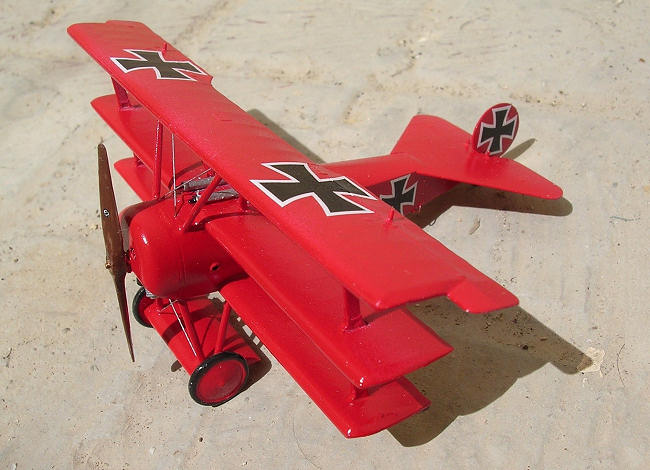
Eduard 1/72 Fokker Dr.I
| KIT: | Eduard 1/72 Fokker Dr.I |
| KIT #: | ? |
| PRICE: | $12.00 |
| DECALS: | One option |
| REVIEWER: | Carmel J. Attard |
| NOTES: |

| HISTORY |
German pilots serving on the Western
Front
were quick to appreciate the high rate of climb and
remarkable maneuverability of the Sopwith Triplane which the RNAS were operating
in the spring of 1917. Consequently, 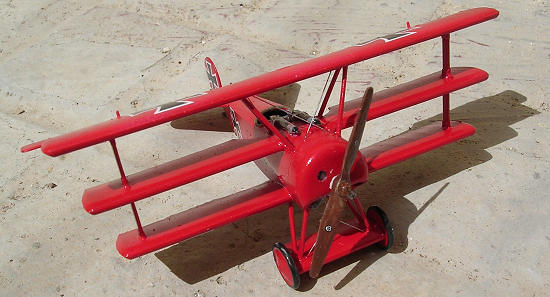 little
time in developing experimental triplanes. Fokker’s chief designer Martin
Kreutzer, was killed on
little
time in developing experimental triplanes. Fokker’s chief designer Martin
Kreutzer, was killed on
The origin of the Fokker V4 can be
found in an order placed in May 1917by the Imperial Austro-Hungarian army air
service for a single seat fighter biplane., but this concept was then revised to
a triplane layout with three small cantilever wings powered by a 120hp Le Rhone
rotary engine and it was immediately discovered that the wings vibrated badly.
The type was therefore revised with a single I-type interplane strut on each
side as well as horn balanced ailerons and elevators. In August 1917
Fokker had meanwhile
received a German contract for another V4 as well
as two V5 prototypes with a central wing intermediate in span between the upper
and lower wings and powered by a Le-Rhone 110hp engine that was entering
production in
The Dr1 soon gained its exaggerated reputation of capability, probably because it was used by a number of major aces including the legendary ‘Red Baron’ who favored the type for its maneuverability and high rate of climb. As far as the speed was concerned however it was inferior to contemporary allied fighters and a number were lost as a result of wing structure failure. For a time the Dr1 was grounded until wing strengthening modifications were carried out. When production ended in May 1918 some 320 such aircraft had been built. And the type remained in front line service until the summer of 1918.
| THE KIT |
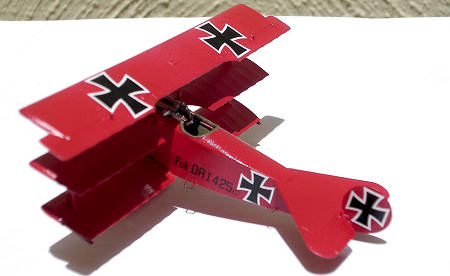 This is
yet another kit of the Fokker Triplane made to 1/72 scale. The earliest known
type in injection moulded plastic goes back to almost 40 years and since then
there has been a lot of improvement in the process of producing the kit and the
quality of detail and scale that comes with this latest release is never in
question but indeed worthy of praise. This is probably the third time that
Eduard released the Triplane in yet a different colour scheme from previous ones
flown by the same Manfred Von Richthofen, the WWI ace. This comes as a standard
kit yet free from any photo etch parts and is distinguished as Dr1 425/17.
Perhaps this release is the one with the most straightforward scheme as it is
overall red finish and is the more likely finish that we attach to the Baron
whenever his name crops up.
This is
yet another kit of the Fokker Triplane made to 1/72 scale. The earliest known
type in injection moulded plastic goes back to almost 40 years and since then
there has been a lot of improvement in the process of producing the kit and the
quality of detail and scale that comes with this latest release is never in
question but indeed worthy of praise. This is probably the third time that
Eduard released the Triplane in yet a different colour scheme from previous ones
flown by the same Manfred Von Richthofen, the WWI ace. This comes as a standard
kit yet free from any photo etch parts and is distinguished as Dr1 425/17.
Perhaps this release is the one with the most straightforward scheme as it is
overall red finish and is the more likely finish that we attach to the Baron
whenever his name crops up.
The kit comes sealed in a polythene bag and consists of two sprues in light tan plastic with all the parts so clearly and finely moulded of same level that one expects from Eduard for the past recent years. There is more about this kit in the preview pages elsewhere on the web.
| CONSTRUCTION |
There is a one-page
instruction sheet written in Czech language with a pretty 4-view drawing, which
depicts an overall red colour Fokker DR1 on one side, and detail stages of
assembly on the other.. Fabric effect on all wing parts is nicely done and the
kit contains cockpit interior detail consisting of an accurate seat, control
stick floor and detailed pair of machine guns. There is also
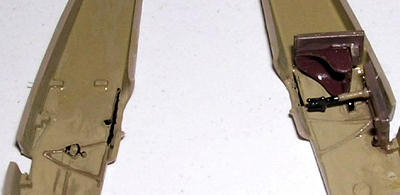 moulded
in side panel details. Yet the cockpit is so small that the detail along with
any extra details that one may desire to add to the interior will be practically
lost. All the parts fit well and in spite of its size this is an easy kit to
build.
moulded
in side panel details. Yet the cockpit is so small that the detail along with
any extra details that one may desire to add to the interior will be practically
lost. All the parts fit well and in spite of its size this is an easy kit to
build.
While I may not be in favour of adding any cockpit detail apart from that supplied with the kit there are a couple of items that may be recommended to add to the exterior. These are the bracing wires that go between the wheel struts, and in front of the cockpit. These were carefully made by passing invisible thread through tiny-drilled holes and sealing these with super glue before sanding the origin smooth in line with wing surfaces. Then there are the handgrips at the rear of lower fuselage and also the side step which although this item is supplied I decided to replace it with one fashioned from thin steel wire. Very little in way of putty was added at the lower wing joining the fuselage which was sanded smooth.
| COLORS & MARKINGS |
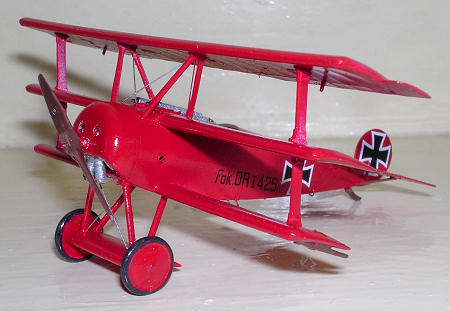 The kit
was given a coat of fine matt white finish followed by Tamiya acrylic bright red
overall. Other items as the machine guns, seat, leather around cockpit and also
wheels and skid were painted in their corresponding colours as appearing on the
4-view colour drawing given at the back of the one page instruction sheet.
Finally the decal for the model contains very little transparent film around the
edges and is of good quality. These were applied and the completed model was
given a coat of Humbrol satin varnish to find a permanent exhibition place next
to other WWI planes of fame.
The kit
was given a coat of fine matt white finish followed by Tamiya acrylic bright red
overall. Other items as the machine guns, seat, leather around cockpit and also
wheels and skid were painted in their corresponding colours as appearing on the
4-view colour drawing given at the back of the one page instruction sheet.
Finally the decal for the model contains very little transparent film around the
edges and is of good quality. These were applied and the completed model was
given a coat of Humbrol satin varnish to find a permanent exhibition place next
to other WWI planes of fame.
| CONCLUSIONS |
This is a very simple, tiny kit to build. In view of its popularity with famous WW1 German aces this is certainly a model that appeals to 1/72 scale modelers who venture in early combat dog-fighters.
If you would like your product reviewed fairly and quickly, please contact me or see other details in the Note to Contributors.